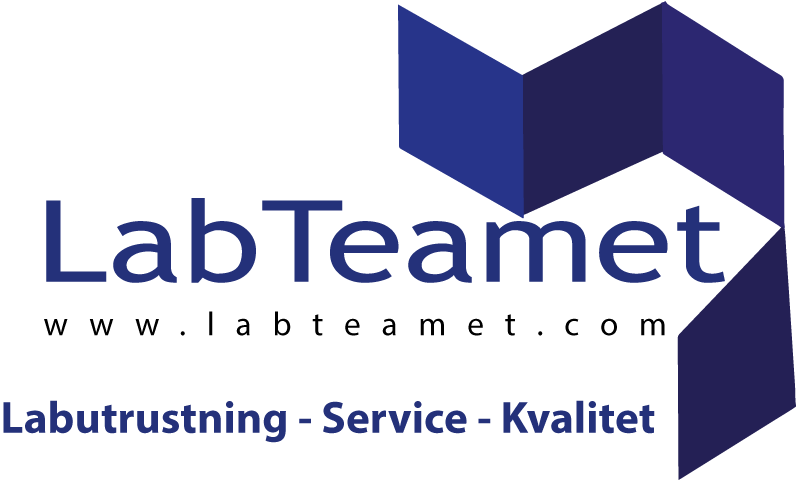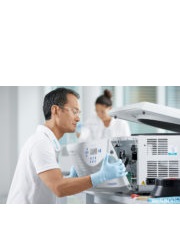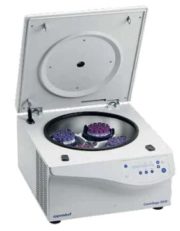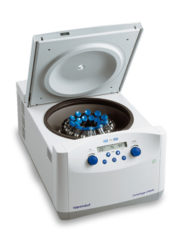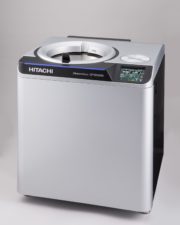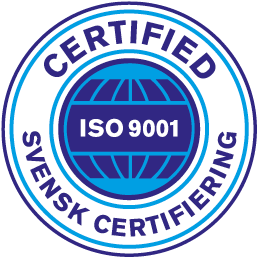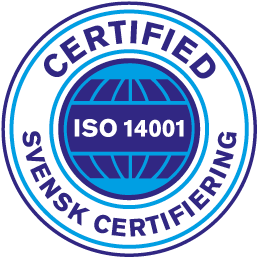Underhåll av Centrifug
Underhåll av Centrifug
Din centrifug är värdefull och essentiell för din forskning eller innovation. För att se till att den håller länge är ordentlig vård nödvändigt. Följ tillverkarens instruktioner och kontrollera regelbundet för korrosion eller skada. Ta inte risken att orsaka skada och sök hjälp från manualen eller tillverkaren vid osäkerhet.
042-300 91 30
Frågor? Ring kundtjänst
It’s the same for everything that’s important to you – if you treat it properly and handle it with care, you will be able to enjoy it for a long time. Your centrifuge was surely not cheap. No wonder, considering the amount of technical innovation, human effort and precious materials involved in creating this valuable device. You probably intend to use it for a scientific or medical research or an innovation that makes our daily lives easier in some way. And you would like to work towards these goals without any problems along the way. This is why you should care for it – on a daily, weekly and annual basis. We are going to show you how to do that correctly and effectively. First, pay attention to the manufacturer’s recommendations. If you can’t find what you are looking for in the user manual, contact the manufacturer. Otherwise you risk damaging the centrifuge, accessories or rotors. Please also check the centrifuge regularly for damage caused by corrosion.
Cleaning & disinfection
Switch off the device and disconnect it from the power supply before starting any cleaning or disinfection.
- The outside of the centrifuge and the rotor chamber should be cleaned regularly with neutral detergents. This is for hygienic purposes as well as to prevent contamination caused by residual contamination.
- Only neutral agents may be used for cleaning and disinfection (e.g. diluted neutral alcohol-based disinfectant or 70% isopropanol mixture).
- Residue from detergents should be removed. Also remove condensation and clean the condensation tray. Leave the centrifuge lid open.
- The rotor chamber and the rotor shaft should simply be wiped with a moist cloth. Please clean your rotor using a neutral cleaning liquid. This will protect the rotor and prolong its service life.
Do not use acetone, caustic detergents, or detergents that contain chlorite ions. Corrosion is most frequently caused by using chlorite ion solutions, such as sodium hypochlorite (household bleach). Do not use steel wool, wire brushes, abrasives, or sandpaper, since they may damage the rotor coating (anodized coating) and thus increase the risk of corrosion. We do not recommend putting rotors or lids into the dishwasher, since the aggressive cleaning agents used in dishwashers may result in corrosion.
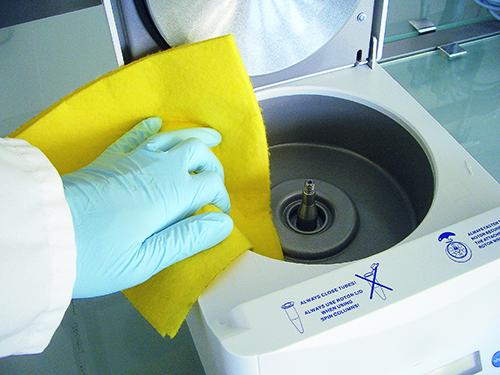
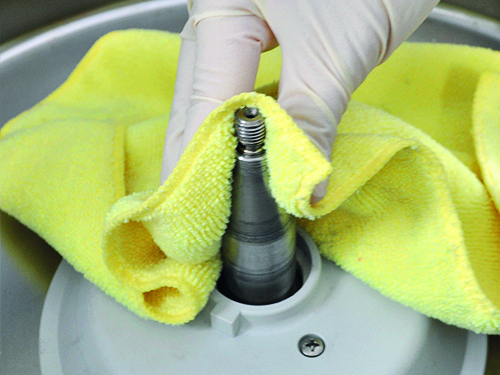
Rotors & accessories
When using a swing-bucket rotor, ensure that the bucket grooves are free of contamination. The buckets can be lubricated with a lubricant (grease for pivots). Ensure that the buckets can swing out completely, especially when using new tube formats.
If aggressive liquid is spilled on your centrifuge equipment, clean it immediately with a neutral cleaning liquid (alcohol or alcohol-based disinfectant). This will protect the rotor and prolong its service life.
Since salt crystals located on the metal surface will corrode the surface, we strongly recommend cleaning the equipment immediately after every use.
If there is a stubborn stain, clean with a plastic scrub pad. If you need to clean the rotor’s tube cavities or boreholes, use a stiff test-tube brush that has end bristles and a non-metallic tip. Rinse equipment with distilled water and dry thoroughly with a soft cleaning cloth.
Do not submerge the rotor in water completely, since water can remain in the rotor cavities, leading to imbalances during following runs.
Suitable and unsuitable cleaning devices:
Allowed:
- Plastic scrub pad
(in case of stubborn contamination) - Stiff brush with end bristles and a non-metallic tip
(if you need to clean the rotor’s bore holes)
NOT allowed:
- Steel wool
- Abrasives
(might create corrosion)
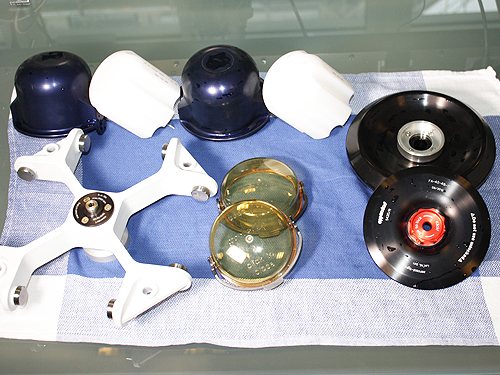
Decontamination / disinfection
Contamination of the rotor through biological material (such as blood) or radioactive material may occur even when you work accurately and carefully. If this happens, please consult your laboratory safety officer first about suitable methods of cleaning and disinfecting hazardous spills within the centrifuge/rotor. Successful disinfection can only be granted by the suppliers of the chemicals.
Before using any cleaning or disinfection method other than what is recommended by the centrifuge manufacturer, please check that the intended method will not damage the rotors, accessories, or other parts of the centrifuge.
Please be aware that the detergents and disinfections are only recommended due to their compatibility with material of the centrifuges. The recommended methods for decontamination are disinfection with alcohol-containing liquids and autoclaving.
Do not use UV, beta, gamma, or any other high-energy radiation source for disinfection. Do not use gas for disinfection.
In general, disinfection with a cloth is more efficient than spraying liquids on the centrifuge, which may also result in a short-circuit within the centrifuge housing. After cleaning with detergent, the rubber seals in the rotor chamber should be rinsed well with distilled water and lubricated with glycerine to prevent them from becoming brittle.
Autoclaving
The sterilization of rotors and accessories may be desirable to protect humans from pathogens or samples from contamination. Sterilization is a process that eliminates all forms of microbial life, including transmissible agents such as bacteria, viruses, fungi, spore forms, etc.
A widely-used method for heat sterilization is autoclaving, where equipment and other objects are sterilized with hot steam. For instance, a typical autoclaving program is performed at 121 °C and 2-bar atmospheric pressure for 15 to 20 minutes.
All fixed-angle and many swing-out rotor crosses as well as all buckets from Eppendorf have been rigorously tested and approved under these conditions. They also have a special anodized coating, which protects the metal from deeper corrosion effects. Steel swing-bucket rotor crosses with a heat-fixed powder coating are not suitable for autoclaving. If you are in doubt about your rotor, please ask the manufacturer whether autoclaving is possible for that model.
Eppendorf offers a second type of aluminum fixed-angle rotor with a special PTFE coating, which has outstanding chemical resistance against phenol, acetonitrile, DMSO, acetone, trichloroacetic acid, acetic acid and sodium hypochlorite. This coating is applied on top of the actual anodic coating.
In some cases, autoclaving at temperatures of 121 °C for 20 minutes may not be sufficient to sterilize a rotor. Prions, such as those associated with Creutzfeld-Jakob disease, can not be destroyed in these conditions. Some manufacturers state that autoclaving at 134 °C for at least 18 minutes should be sufficient [1], but in some cases, even this is not enough to deactivate the disease agent, especially when using material with very high infectiousness. Prions generally have a high heat resistance, although their infectivity can be reduced by such a treatment.
A maximum temperature of 121 °C is not suitable for the destruction of prions. Therefore, higher temperatures are necessary. According to available marketing material, only a few rotors on the market can be autoclaved at higher temperatures than 121°C. The customer thus has a very limited choice of available rotors – including Eppendorf’s high-quality aluminum rotors –for these applications. Selected Eppendorf rotors have been extensively tested at 142 °C for 2 hours or 135 °C for 20 min. These Eppendorf rotors can be used with confidence for such applications.
Lubrication
After cleaning your equipment, take a small amount of centrifuge lubricant – like polyethlene glycol (PEG) fat provided by Eppendorf – on your finger. Lubricate bucket grooves, pivots of swing-bucket rotors, and rubber seals. Rotor chamber seals can be lubricated with standard laboratory grade glycerol or talcum. Check whether the seals of aerosol tight lids/caps need to be replaced, because aerosol-tightness is only possible with undamaged seals. Lubricate the threads of the fixed angle rotors after cleaning and autoclaving. Light waxing of anodized rotor surfaces may also extend service life. Use a soft cloth for the waxing procedure.
Recommended routine maintenance
Daily:
Before and after use, check the rotor and lid for scratches, dust, or spilled sample material. (Missing anodization on a rotor made of aluminum is a clear indication that a more detailed evaluation is necessary.)
When using an aerosol-tight rotor, check the seal of the lid.
Clean your centrifuge on a regular basis to protect your investment and to maximize the lifetime of your instrument and guarantee operational safety, e.g. to prevent accumulation of deposits and to eliminate any possibility of corrosion.
If necessary, wipe the following parts with a lint-free microfiber cloth:
Centrifuge housing
Chamber
Rotor shaft
Rotor
Rotor lid/caps
Keep the lid of the centrifuge open to reduce pressure on the spring lifts of the centrifuge lid. For refrigerated centrifuges, leave the lid of the centrifuge and the rotor open and allow the device to defrost over night.
Weekly to monthly:
Keep a maintenance log.
Carefully remove rotor from centrifuge.
Make a detailed inspection of the centrifuge rotor, rotor lid, and buckets for cracks and corrosion. For a fixed-angle rotor, check underneath the rotor as well as the tube bores. For a swing-bucket rotor, pay special attention to the pivots and grooves. Differentiate clearly between a scratch and a gouge (= more than damaged color) when evaluating your rotor. A rotor with a gouge or even a small crack must be replaced. Due to the manufacturing process, color variations may occur on rotors marked „coated”. These color variations do not affect service life or resistance to chemicals.
Annually:
Check with your local safety officers for any local regulations regarding centrifuge maintenance. For example, in Germany, regulation DGUV 100 – 500 (formerly BGR 500) requires centrifuges exceeding 500 W nominal power consumption (without refrigeration system) or 10,000 Nm kinetic energy to be inspected by an authorized technician at least once a year in operating condition and at least every three years in a disassembled state.
Eppendorf recommends an annual preventive maintenance inspection by a trained service technician of the centrifuge, rotor, and accessories to guarantee operational safety and maximize the service life of your instrument.
When using refrigerated centrifuges, clean the refrigeration mesh of the heat exchanger with a brush at least twice a year. We further recommend cleaning the condensate drainage channels on a regular basis, e.g. using a narrow bottle brush.
References
[1] Lawson, V. A. et al. (2007). Enzymatic detergent treatment protocol that reduces protease-resistant prion protein
load and infectivity from surgical-steel monofilaments contaminated with a human-derived prion strain.
J Gen Virol vol. 88 no. 10: 2905–2914
